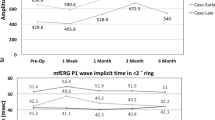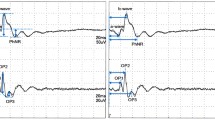Abstract
In three eyes with a retained intraocular metallic foreign body, the neural retina and retinal pigment epithelial (RPE) integrity were evaluated by means of ERG (a-wave, b-wave, oscillatory potentials) and non-photic EOG responses from the RPE (hyperosmolarity response, Diamox response, bicarbonate response). All three cases were judged in an early stage of retinal impairment on the basis of a well-preserved or supernormal b-wave amplitude and showed good postoperative prognosis. Out of three non-photic responses from the RPE, only the bicarbonate response was preoperatively reduced in two out of the three eyes.
Similar content being viewed by others
References
Segawa Y. Electrical response of retinal pigment epithelium to sodium bicarbonate, II: Clinical use for evaluation of retinal pigment epithelium activity. J Juzen Med Soc 1987; 96: 1022–1041.
Isikawa K, et al. Synopses of clinical features in intraocular foreign bodies. Ophthalmology (Tokyo) 1965; 7: 541–547.
Yonemura D, et al. In: Clinical electroretinography: principles and practice. Tokyo: Igakushoin, 1985: 179–182.
Makiuchi S. Clinical aspect and pathology of intraocular siderosis. Acta Soc Ophthalmol Jpn 1960; 64: 2234–2257.
Kawasaki K, et al. Retinal function in siderosis bulbi with special reference to drug-induced responses from the retinal pigment epithelium (hyperosmolarity response). Jpn Rev Clin Ophthalmol 1985; 79: 1315–1317.
Duke-Elder. Intraocular foreign bodies. In: System of ophthalmology, Vol. 14. London: Henry Kimpton, 1972: 525–544.
Maezawa N. Ultrastructural changes in the preretinal proliferative tissue encapsulating iron piece. Acta Soc Ophthalmol Jpn 1979; 83: 1749–1755.
Shirane M, et al. Statistical observation of penetrating eye injuries in the decade. Jpn Rev Clin Ophthalmol 1984; 78: 1150–1155.
Appel I, et al. Histopathological changes in siderosis bulbi. Ophthalmologica 1978; 176: 205–210.
Imaizumi K, et al. EOG and ERG of intra-ocular injuries due to iron piece invasion. Jpn J Clin Ophthalmol 1968; 22: 545–551.
Declercq SS, et al. Experimental siderosis in the rabbit. Arch Ophthalmol 1977; 95: 1051–1058.
Masciulli L, et al. Experimental ocular siderosis in the squirrel monkey. Am J Ophthalmol 1972; 74: 638–661.
Knave B. Electroretinography in eyes with retained intraocular metallic foreign body. Acta Ophthalmol 1969; Suppl 100: 3–63.
Karpe G. Early diagnosis of siderosis retinae by the use of electroretinography. Doc Ophthalmol 1948; 2: 277–296.
Watanabe I, et al. In: Clinical ERG and EOG. Tokyo: Igakushoin, 1984: 122–125.
Author information
Authors and Affiliations
Rights and permissions
About this article
Cite this article
Tanabe, J., Shirao, Y., Oda, N. et al. Evaluation of retinal integrity in eyes with retained intraocular metallic foreign body by ERG and EOG. Doc Ophthalmol 79, 71–78 (1992). https://doi.org/10.1007/BF00160133
Accepted:
Issue Date:
DOI: https://doi.org/10.1007/BF00160133




